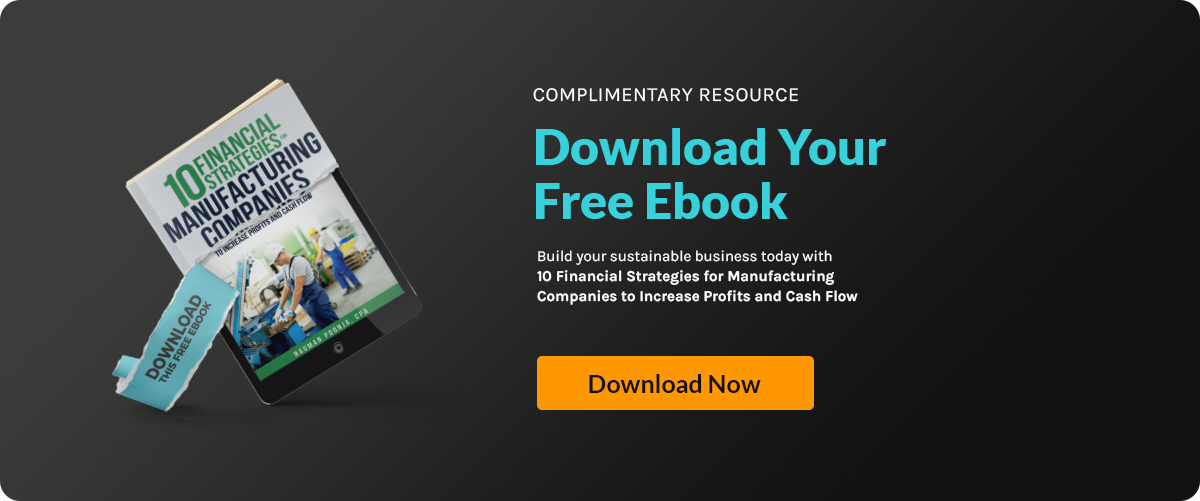Scaling production without a risk plan? That's a dangerous game. When companies grow, so do the...
Financial Risk Management Plan for Manufacturing Success

Running a manufacturing business comes with risks—equipment breaks down, material costs fluctuate, and payments don’t always arrive on time. While some challenges are unavoidable, financial instability doesn’t have to be one of them.
Many manufacturers focus on production efficiency but only react to financial risks once they become a problem. But waiting until cash flow runs tight or expenses spiral makes recovery much harder. The right approach can make a huge difference. In fact, a strong risk management strategies see up to 30% fewer financial losses simply by spotting issues early and making smarter decisions.
A solid financial risk management plan helps manufacturers stay prepared. Here’s how to build a strategy that keeps your finances secure.
Creating a Financial Risk Management Plan for Stability
Unexpected challenges can disrupt operations and slow growth. Without a financial risk management plan, businesses may struggle to cover expenses or recover from setbacks. Identifying and addressing threats early helps maintain stability.
Here are key challenges manufacturers must prepare for:
- Market Fluctuations – Changes in demand, material costs, and interest rates affect profitability.
- Supply Chain Issues – Delays, shortages, or price increases can slow production.
- Protecting Cash Flow – Late customer payments and rising expenses limit available funds.
- Regulatory Compliance – Failing to meet industry standards results in penalties and delays.
- Operational Disruptions – Equipment failure, labor shortages, or process inefficiencies reduce efficiency.
Having a financial risk management plan helps businesses spot early warning signs. A business health check ensures companies stay prepared and avoid costly mistakes. The next step is understanding how regular assessments strengthen long-term stability.
Utilizing a Business Health Check to Spot Financial Weaknesses
Ignoring weaknesses in a company’s finances leads to unexpected problems. Late payments, high expenses, and inefficient operations reduce stability. A business health check helps manufacturers identify and fix these issues before they cause major setbacks. Here's a comparison of a manufacturer’s financial state before and after a business health check.
|
Aspect |
Before Business Health Check |
After Business Health Check |
|
Tracking Expenses |
Unclear spending leads to uncontrolled costs. |
Regular monitoring keeps expenses in check. |
|
Manufacturing Financial Statements |
Inconsistent reports make decision-making difficult. |
Accurate records improve planning and forecasting. |
|
Supplier Payments |
Late payments damage relationships. |
On-time payments strengthen supplier trust. |
|
Profitability |
Poor pricing and high costs reduce earnings. |
Pricing adjustments increase margins. |
|
Protecting Cash Flow |
Gaps in revenue cause funding shortages. |
Predictable inflows maintain stability. |
A business health check highlights areas that need improvement. By reviewing manufacturing financial statements, manufacturers gain better insights into their operations and make stronger business decisions.
Protecting Cash Flow to Keep Operations Running Smoothly
Unexpected disruptions can slow production and lead to lost revenue. Late payments, rising costs, and poor expense management make it harder to keep operations stable. Protecting cash flow ensures that manufacturers can cover expenses, invest in growth, and stay competitive. Below is a step-by-step breakdown of how businesses can maintain stability.
Step 1: Monitor Manufacturing Financial Statements Regularly
Reviewing manufacturing financial statements helps businesses track expenses, identify overspending, and plan for future needs. Consistent monitoring ensures that revenue and expenses stay balanced.
Step 2: Improve Payment Collection Processes
Delayed payments disrupt operations. Sending invoices on time, following up with customers, and offering incentives for early payments help keep funds moving.
Step 3: Reduce Unnecessary Expenses
Cutting non-essential costs increases efficiency. Reviewing supplier contracts, renegotiating pricing, and streamlining operations lower spending and strengthen reserves.
Step 4: Maintain a Reserve for Unexpected Costs
Setting aside emergency funds prevents sudden disruptions. Businesses that prepare in advance can handle equipment repairs, supplier delays, or market downturns without setbacks.
Step 5: Use a Financial Risk Management Plan
A financial risk management plan helps manufacturers anticipate problems before they happen. Planning for possible disruptions ensures businesses remain stable in changing market conditions.
Keeping operations steady requires protecting cash flow through careful planning and regular reviews. Monitoring manufacturing financial statements and using a financial risk management plan help manufacturers stay ahead of potential challenges. Strong financial habits create long-term stability.
How to Use Manufacturing Financial Statements as Risk Indicators
Manufacturers need to understand key data points to stay ahead of potential problems. Numbers alone don’t tell the full story, but the right insights reveal hidden weaknesses. Regular reviews of manufacturing financial statements help protect cash flow and maintain stability.
The following is a breakdown of how to use these statements to spot concerns before they impact operations.
Income Statement: Spotting Revenue & Cost Red Flags
The income statement tracks revenue and expenses. Identifying changes in trends helps manufacturers stay one step ahead. Follow these key indicators to spot potential issues:
- Look for declining revenue trends – A steady drop in sales signals reduced demand or pricing issues.
- Identify rising operational costs that hurt profit margins – Increased material costs, labor expenses, or inefficiencies can weaken earnings.
- Watch for shrinking net profit percentages – If revenue grows but profits decline, production costs or overhead may need adjustments.
Balance Sheet: Assessing Financial Stability
A strong balance sheet ensures long-term success. Monitoring assets and liabilities helps manufacturers understand their financial position. Try doing these to assess stability:
- Check if liabilities outweigh assets (excessive debt) – A high debt load makes it harder to cover business obligations.
- Monitor cash reserves—low liquidity means high risk – Insufficient reserves leave no buffer for unexpected costs.
- Review inventory turnover—slow sales may indicate financial trouble – Excess stock ties up resources and increases storage costs.
Cash Flow Statement: Identifying Liquidity Issues
Tracking how money moves through the business prevents disruptions. Unstable cash inflows create problems in daily operations. Look out for these signs of liquidity issues:
- Watch for irregular cash inflows and outflows – Large gaps between payments and expenses lead to shortfalls.
- Negative cash flow for consecutive periods signals risk – If more money is going out than coming in, adjustments are needed.
- Delayed payments from customers can lead to cash shortages – Late invoices slow down supply chain payments and production.
Financial Ratios: Quick Risk Assessment
Ratios simplify complex financial data, providing a snapshot of overall performance. Check these key ratios to measure financial health:
- Debt-to-equity ratio – High levels mean over-reliance on debt, increasing vulnerability.
- Current ratio – Low numbers indicate difficulty covering short-term expenses.
- Working capital ratio – A declining trend suggests potential operational struggles.
Regular analysis of manufacturing financial statements helps businesses make informed decisions. Strengthening reporting and protecting cash flow ensures long-term success. Professionals like Accounovation support manufacturers by providing insights that improve financial stability and business performance.
Use A Smarter Way to Manage Financial Risks
Unexpected costs can shake up even the most well-run manufacturing business. When cash flow gets tight or expenses rise, it creates pressure that’s hard to ignore. Without a clear plan, small issues can quickly turn into bigger financial setbacks.
At Accounovation, we help manufacturers stay ahead of financial risks with better planning and forecasting. Our approach gives you the clarity and control you need to manage uncertainty and keep your business moving forward. Get in touch with us, and let’s build a stronger plan together.







